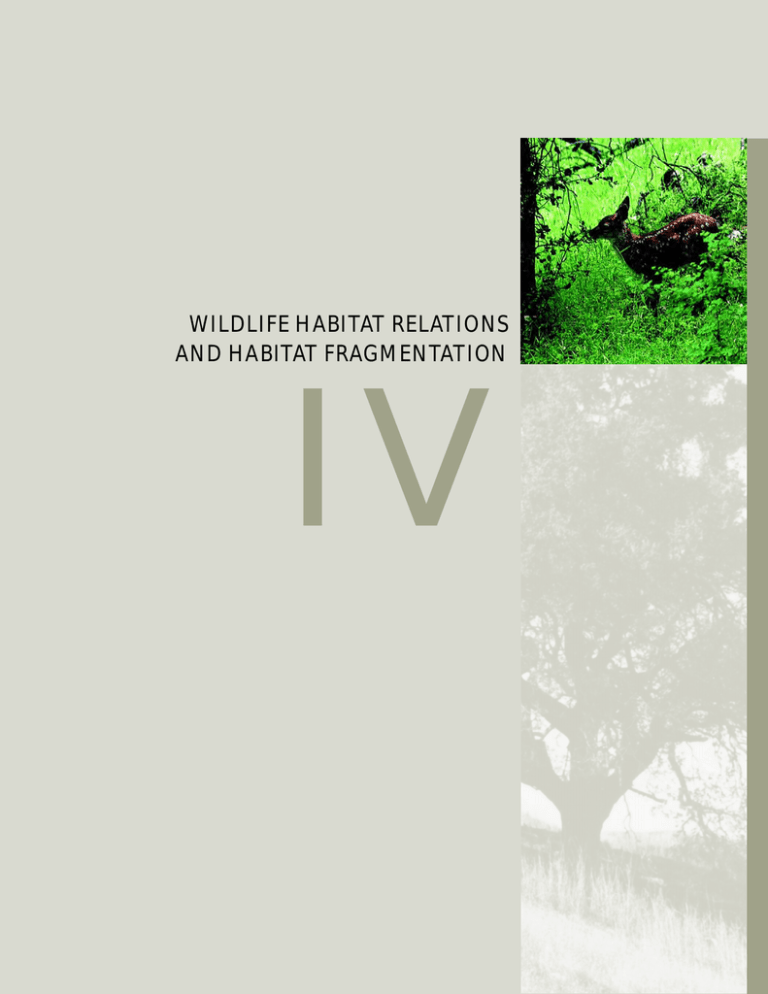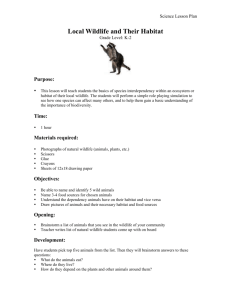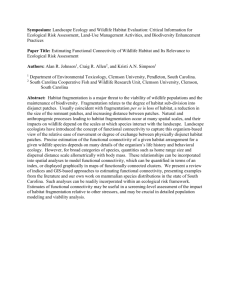IV WILDLIFE HABITAT RELATIONS AND HABITAT FRAGMENTATION
advertisement

WILDLIFE HABITAT RELATIONS AND HABITAT FRAGMENTATION IV Section Overview Wildlife Habitat Relations and Habitat Fragmentation in California’s Hardwood Rangelands1 Barrett A. Garrison2 Frank W. Davis3 T he nine papers in the following section on wildlife habitat relations and habitat fragmentation in hardwood rangelands from this symposium illustrate the wide diversity of these two research topics. With increasing humaninduced changes to California’s hardwood rangeland habitats, it is important that we understand how wildlife relate to these habitats and how wildlife are affected when habitat fragmentation occurs. This section provides some key sources of information in these areas. Wildlife Habitat Relations Three papers on bird communities (by Aigner and others, Tietje and others, Verner and others) and one paper on mammal communities (by Laudenslayer and Fargo) are excellent examples of the complexity of these communities and the difficulty in studying them. The papers by Aigner and others and Verner and others resulted from studies in which assessing the impacts of land management activities on birds was a major objective. While Verner and others reported on these impacts, both papers discussed many of the methodological problems associated with these types of studies. Furthermore, Verner and others noted that bird communities in a single grazed plot were relatively similar to those in a single ungrazed plot, although populations of two problematic birds, the brownheaded cowbird (Molothrus ater) and starling (Sturnus vulgaris), appeared to have increased with grazing. Two papers provided basic natural history information on nesting habitats of two raptorial birds, the red-tailed hawk (Buteo jamaicensis) (by Tietje and others) and California spotted owl (Strix occidentalis occidentalis) (by Steger and others). These two natural history studies provide extremely useful information to wildlife scientists and managers recommending and implementing actions intended to conserve these two important raptors. Structural components of hardwood rangeland habitats, such as logs and snags, are rarely studied, so the paper by Tietje and others on downed woody debris helps fill an obvious data gap. Data gaps for habitat components are particularly onerous because most conservation recommendations are directed at habitat components, not wildlife populations and communities. Habitat Fragmentation Habitat fragmentation is any process that reduces habitat continuity (Lord and Norton 1990). Oak (Quercus spp.) woodland habitats are fragmented by environmental processes and human activities across a wide range of spatial scales. To date, there has been very little research into either the spatial pattern of USDA Forest Service Gen. Tech. Rep. PSW-GTR-160. 1997. 1Presented at the Symposium on Oak Woodlands: Ecology, Management, and Urban Interface Issues, March 19–22, 1996, San Luis Obispo, Calif. 2Senior wildlife biologist, Wildlife Management Division, California Department of Fish and Game, 1416 Ninth Street, Sacramento, CA 95814. 3Professor, Department of Geography, University of California, Santa Barbara, CA 93106. 353 Garrison and Davis Brief Overview of the Session on Wildlife Habitat Relations fragmentation in hardwood rangelands or the effects of habitat fragmentation on the distribution and abundance of wildlife species. Of the two papers presented in the Habitat Fragmentation section, one focused on fragmentation patterns and processes, and one was more concerned with wildlife effects. Stephenson and others [these proceedings] considered regional trends in oak woodland habitats in southern California and described a coordinated regional planning effort to conserve remaining habitats. Garrison and Standiford combined plot data and growth model projections to characterize habitat changes due to tree cutting at 19 ranches in Shasta and Tehama counties. Habitat relationships models for 21 species predicted that only one species would be negatively affected by woodcutting, while seven would be positively affected and 13 would be unaffected. Acknowledgments Funding for the staff time of Barrett Garrison to write this paper was provided by the Pittman-Robertson Federal Aid in Wildlife Restoration Act. References Aigner, Paul A.; Block, William M.; Morrison, Michael L. Design recommendations for point counts of birds in California oak-pine woodlands: power, sample size, and count stations versus visits. [These proceedings] Garrison, Barrett A.; Standiford, Richard B. A post-hoc assessment of the impacts to wildlife habitats from wood cutting in blue oak woodlands in the northern Sacramento Valley. [These proceedings.] Laudenslayer, William F., Jr.; Fargo, Roberta J. Small nocturnal mammals in oak woodlands: some considerations for assessing presence and abundance. [These proceedings] Lord, Janice M.; Norton, David A. 1990. Scale and the spatial concept of fragmentation. Conservation Biology 4: 197-202. Steger, George N.; Eberlein, Gary E.; Munton, Thomas E.; Johnson, Kenneth D. Characteristics of California spotted owl nest sites in foothill riparian and oak woodlands of the southern Sierra Nevada, California. [These proceedings]. Stephenson, John R.; Volgarino, Deveree A.; Nichols, G.A.; White, Thomas C. Developing a conservation strategy for southern California forests and woodlands. [These proceedings]. Tietje, William D.; Berlund, Tristan C.; Garcia, Sergio L.; Halpin, Christopher; Jensen, Wayne A. Contribution of downed woody material by blue, valley, and coast live oaks in central California. [These proceedings]. Tietje, William D.; Bloom, Peter H.; Vreeland, Justin K. Characteristics of red-tailed hawk nest sites in oak woodlands of central California. [These proceedings]. Tietje, William D.; Vreeland, Justin K.; Siepel, Nancy K.; Dockter, Jo Ann L. Relative abundance and habitat associations of vertebrates in oak woodlands in coastal-central California. [These proceedings]. Verner, Jared; Purcell, Kathryn L.; Turner, Jennifer G. Bird communities in grazed and ungrazed oak-pine woodlands at the San Joaquin Experimental Range. [These proceedings]. 354 USDA Forest Service Gen. Tech. Rep. PSW-GTR-160. 1997.







